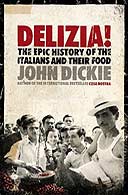
Delizia! The Epic History of the Italians and their Food, by John Dickie
240pp, Sceptre, £20
A Late Dinner: Discovering the Food of Spain, by Paul Richardson
310pp, Bloomsbury, £16.99
Time was a traveller's holdall would be crammed with Baedekers and Blue Guides. Palaces, churches, galleries and temples, sometimes a garden, maybe a vista, would make the holiday checklist. No longer. The Michelin guide, a handbook for shopaholics and helpful studies of food habits, phrases and markets are more likely candidates for hand luggage today. Our parents may have cantered down the aisles of Notre Dame, but we prefer the produce aisles in an Ipercoop (Italy) or Leclerc (France). If you are of this mind, much profitable reading is in store in both these books.
They approach the business of eating from opposite directions. John Dickie is a historian, Paul Richardson an intelligent journalist. Dickie has chosen to write of the relationship of Italians to their food, but not a history of Italian food itself. Richardson composes a present-day travelogue, almost a restaurant guide, but plumbing sufficient depths of historical, culinary and anecdotal knowledge to raise it far above the one-star, two-star preoccupations of Michelin or Gault-Millau.
Dickie's big theory is that we should forget our worship of Italian peasants and their perfect diet and concentrate instead on the influence of the big cities. Italy was never a country, always an agglomeration of small city-states. While peasants starved, or scratched terrible meals from meagre materials, the city elites lorded it over their markets and dependent agricultural territories. As if to emphasise the point, Dickie gives each city a chapter, pinpointing a single foody moment or culinary angle in its past to construct a clever and provoking account of Italy's history.
Richardson is concerned to a greater extent with the now of Spanish cooking. The work of master-chef Ferran Adrià at El Bulli in Catalonia is but the apogee of a root-and-branch renewal of Spanish food that dates back to nouvelle cuisine and its adoption by Basque cooks and restaurants in the late 1970s. He seeks to explain this transformation of what might be thought a pretty iffy style of cookery. (Certainly, few English travellers have had a good word to say of the food they have met on their visits, while it's undeniable that today Spanish restaurants are at the top of the culinary tree.) His view is that this renaissance could never have happened, and would have had no meaning, were it not undertaken by men with their feet planted firmly in the soil of tradition. He delights in discovering the most stellar restaurant, with a chef happily turning out deconstructed classics of Basque or Castilian peasant dining -think Heston Blumenthal with a Spanish accent - where the acknowledged start of it all was a neighbourhood bar run by said chef's parents, transformed by the wild ambition and creativity of the younger generation. So, if Dickie traces Italian cooking through its social and economic elites, Richardson is looking constantly back to the humble origins of the food of Spain.
The rewards of these books lie principally in the pleasing contradictions they explore in our attitudes to food. Think, for example, of our glorification of the peasant lifestyle. Would the River Café or Hugh Fearnley-Whittingstall have much meaning were the nebulous backdrops of a Tuscan farmhouse or a straw-chewing Dorset labourer not ever-present? Neither Dickie nor Richardson has many illusions about the wonders of the peasant diet. Dickie quotes the horror of one English lady offered a pork soup near Ferrara containing the "hog's head, with the eyelashes, eyes, and nose on; the very food the wretched animal had last eaten of before he made his exit remained sticking about the teeth". Richardson makes the point that 17th-century Spanish literature portrayed food not in terms of plenty and delight but of hunger and deprivation: "the perpetual search for food is the underlying theme". Neither does either writer suggest that peasant cooking was the be-all and end-all of their national styles.
One of Dickie's killer facts, with which he opens his account, is the existence in Tuscany of Il Mulino Bianco (The White Mill), a restaurant that offers the culinary epitome of old Italy. In fact, it was no peasant paradigm but the set for an advertising campaign for a leading brand of biscuits. Dreary industrial wasteland was not a fitting frame for the product, hence the choice of this mill. A constant flow of visitors still ask the chef if he makes the biscuits himself.
Such mismatches of perception are seen most forcefully in our current yen for offal. Send a foody to Palermo and he will ignore every monument until the famous spleen sandwich, the guastella, has passed his lips. Asked to account for the glories of the cooking of Cádiz on Spain's Atlantic coast, Richardson gives a catalogue of dishes cooked up by the fishermen who for 3,000 years have caught tuna heading for the Strait of Gibraltar. These include casserole of tuna skin, tuna entrails with chickpeas, tuna heart with vinegar or tuna cheeks with potatoes. But all these delicacies, like the udder (elder) of east Lancashire or the tripe of Caen in Normandy, were the poor man's scraps from the trough of luxury. On such matters, both Spain and Italy have plenty to say. It's holiday reading that informs as well as enlightens. But don't forget the cathedral.
· Tom Jaine runs Prospect Books, a specialist food imprint.

